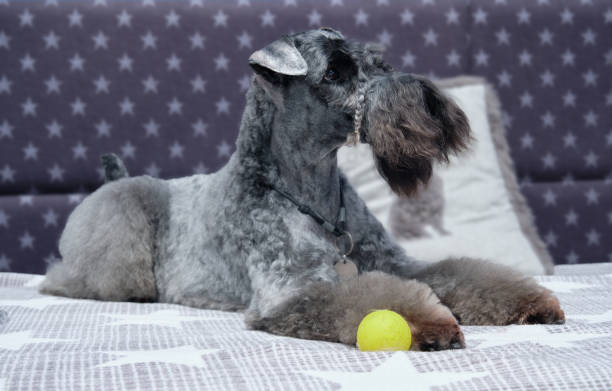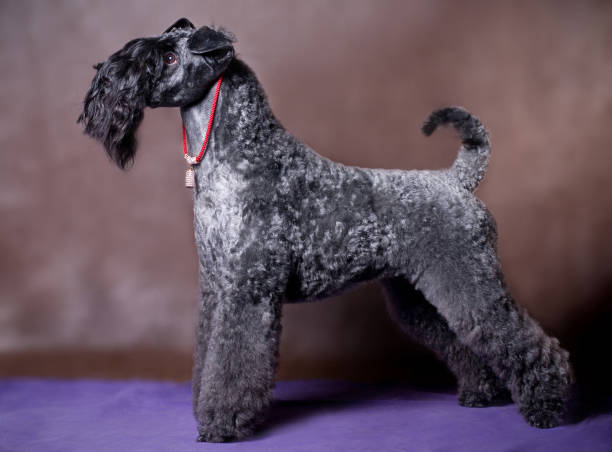Kerry Blue Terrier

Breed History:
The Kerry Blue Terrier, also known as the Irish Blue Terrier, originated in County Kerry, Ireland, in the 18th century. Though its exact ancestry is unclear, it likely descends from a mix of native Irish terriers and possibly the Portuguese Water Dog or Wheaten Terrier. It was bred to be a versatile farm dog, capable of hunting vermin, guarding the home, and herding livestock.
The Kerry Blue was officially recognised by the Irish Kennel Club in 1922 and the American Kennel Club in 1924. It gained popularity in post-independence Ireland as a symbol of national pride. Despite its rugged, working background, the Kerry Blue became known for its elegant appearance and dignified attitude in the show ring.
|
Gender |
Height |
Weight |
|
Male |
46-50 cm |
15-18 kg |
|
Female |
44-48 cm |
14-117 kg |
Size – Medium
Life Expectancy: 12–15 years

Breed Appearance:
The Kerry Blue Terrier is a well-muscled, compact, and stylish terrier with a distinctively soft, wavy coat that comes in shades of blue-gray, which darkens with age (puppies are born black). Its hallmark coat has a unique texture, often compared to fine human hair, and is non-shedding.
It features a long, flat head, dark, keen eyes, small V-shaped ears folded forward, and a beard and bushy eyebrows that give it a bold, intelligent expression. The tail is typically docked in countries where the practice is still permitted and is carried upright.
Breed Type – Working/Terrier:
Bred as a farm utility dog, the Kerry Blue Terrier combines the classic tenacity of terriers with the versatility of a working breed. It is courageous, alert, and protective, making it an excellent watchdog and a loyal family companion.
This breed is known for its strong-willed personality and may be reserved or assertive toward unfamiliar dogs. With proper socialization, it can get along with other pets, but it generally prefers being the dominant animal in a household.

Training:
The Kerry Blue is highly intelligent and capable of learning quickly, but it also has a stubborn, independent streak. Training must be consistent, confident, and engaging. Positive reinforcement works well, especially when sessions are kept short and varied.
Early socialization is vital to avoid dog aggression or shyness. The Kerry Blue excels in obedience, agility, and herding, and thrives when given a job or regular mental stimulation.
Health & Care:
The Kerry Blue Terrier is a generally healthy breed with a good lifespan. However, some health concerns include:
-
Hip dysplasia
-
Eye conditions (cataracts, entropion)
-
Cystic follicular dysplasia (a coat condition)
-
Hypothyroidism
Routine health screenings and regular vet checkups are recommended. This breed is not prone to common terrier issues like luxating patellae or heart problems.

Living Conditions:
The Kerry Blue can adapt well to apartment living, provided it receives enough physical and mental exercise. It is a loyal house dog that prefers being around its family and does not do well left alone for long periods.
Because of its watchdog instincts, it may bark to alert its owners but is not known to be excessively vocal. A secure yard is recommended if off-leash time is allowed, as the breed may chase smaller animals.
Exercise:
The Kerry Blue requires moderate to high daily exercise, ideally 1 to 1.5 hours per day. This includes walks, playtime, and training sessions. It enjoys interactive activities like fetch, scent work, and agility.
Without enough stimulation, it can become bored, vocal, or destructive. It is a great match for active individuals or families who enjoy outdoor activities.
Grooming:
This breed has a non-shedding, hypoallergenic coat, but it requires significant grooming:
-
Brush 2–3 times per week to prevent matting
-
Professional trimming every 6–8 weeks to maintain its sculpted look
-
Clean ears regularly to avoid infections
-
Trim nails and maintain dental hygiene
The coat does not naturally repel dirt, so regular baths are necessary to keep it clean and healthy.

Advantages:
-
Intelligent, trainable, and alert
-
Hypoallergenic and non-shedding coat
-
Loyal and protective of its family
-
Adaptable to various living environments
-
Excels in sports and obedience
-
Strong personality with a stylish appearance
Disadvantages:
-
Requires regular grooming and coat maintenance
-
Can be stubborn or independent during training
-
May be aggressive with other dogs without proper socialization
-
Needs consistent mental and physical exercise
-
Not ideal for first-time dog owners
-
Can become territorial or possessive if not properly managed

